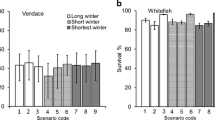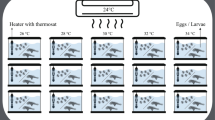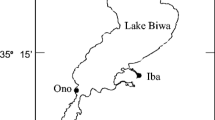Abstract
Effect of temperature on the development of eggs of round herring Etrumeus teres was experimentally examined to construct a temperature-dependent egg development model. Mature fish were collected in the field and their eggs were artificially fertilized onboard. The eggs were incubated at nine temperatures set between 14.0 and 25.0°C. All eggs at the lowest three temperatures, 14.0°C, 15.0°C, and 16.0°C, ceased development and died at various stages before hatching. Durations required to hatching after fertilization ranged from 38.0 h at 25.0°C to 90.0 h at 17.5°C. The temperature-dependent egg development model, i.e., egg age in hours (y i,t ) at the ith stage and temperature t (°C), was expressed as: y i,t = 4.604 × exp(−0.100 × t −0.129 × i) × i 2.593. From the application of the model to early-stage eggs collected in the field, it is concluded that round herring starts spawning immediately after sunset and almost completes spawning by midnight. The temperature-dependent egg development model and the daily pattern of spawning presented in this study are essential tools for developing the daily egg production method to estimate the spawning stock biomass.


Similar content being viewed by others
References
Parker K (1980) A direct method for estimating northern anchovy, Engraulis mordax, spawning biomass. Fish Bull 78:541–544
Lasker R (1985) Introduction: an egg production method for anchovy biomass assessment. In: Lasker R (ed) An egg production method for estimating spawning biomass of pelagic fish. Application to the northern anchovy, Engraulis mordax. NOAA Tech. Rep. NMFS 36, pp 33–35
Alheit J (1993) Use of the daily egg production method for estimating biomass of clupeoid fishes: a review and evaluation. Bull Mar Sci 53:750–767
Kraus G, Köster FW (2004) Estimating Baltic sprat (Sprattus sprattus balticus S.) population sizes from egg production. Fish Res 69:313–329
Somarakis S, Palomera I, Garcia A, Quintanilla L, Koutsikopoulos C, Uriarte A, Motos L (2004) Daily egg production of anchovy in European waters. ICES J Mar Sci 61:944–958
Priede IG, Watson JJ (1993) An evaluation of the daily egg production method for estimating biomass of Atlantic mackerel (Scomber scombrus). Bull Mar Sci 53:891–911
Watanabe C, Hanai T, Meguro K, Ogino R, Kimura R (1999) Spawning biomass estimates of chub mackerel Scomber japonicus of Pacific subpopulation off central Japan by a daily egg production method. Nippon Suisan Gakkaishi 65:695–702
Zeldis JR, Francis RICC (1998) A daily egg production method estimate of snapper biomass in Hauraki Gulf, New Zealand. ICES J Mar Sci 55:522–534
Picquelle SJ, Stauffer G (1985) Parameter estimation for an egg production method of anchovy biomass assessment. In: Lasker, R (ed) An egg production method for estimating spawning biomass of pelagic fish. Application to the northern anchovy, Engraulis mordax . NOAA Tech. Rep. NMFS 36, pp 7–16
Lo NCH (1985) A model for temperature dependent northern anchovy egg development and an automated procedure for assignment of age to staged eggs. In: Lasker R (ed) An egg production method for estimating spawning biomass of pelagic fish. Application to the northern anchovy, Engraulis mordax. NOAA Tech. Rep. NMFS 36, pp 43–50
Whitehead PJD (1985) FAO species catalogue. Vol 7. Clupeoid fishes of the world. An annotated and illustrated catalogue of the herrings, sardines, pilchards, sprats, anchovies and wolf-herrings. Pt 1 – Chirocentridae, Clupeidae and Pristigasteridae. FAO Fisheries Synopsis 125, FAO, Rome
Ishida M (2006) Stock assessment and evaluation for the Pacific stock of round herring (fiscal year 2006). In: Marine fisheries stock assessment and evaluation for Japanese waters (fiscal year 2006/2007). Fisheries Agency and Fisheries Research Agency of Japan, Japan. pp 574–584
Watanabe Y (2002) Resurgence and decline of the Japanese sardine population. In: Fuiman LA, Werner RG (eds) Fishery Science. Blackwell, Oxford, pp 243–257
Ochiai A, Tanaka M (1986) Ichthyology, vol 2. Koseisha-Koseikaku, Tokyo
Ito S (1968) Observations on the ovarian ova of the round herring, Etrumeus micropus (Temminck et Schlegel). Bull Japan Sea Reg Fish Res Lab 19:11–17
Plaza G, Sakaji H, Honda H, Hirota Y, Nashida K (2007) Spawning pattern and type of fecundity in relation to ovarian allometry in the round herring Etrumeus teres. Mar Biol 152:1051–1064
Ishida M, Takeda Y, Imoto E, Hirata M, Tanaka S, Mori Y, Kuroki T, Nojima M, Mitani T, Uehara S (1997) Distribution of eggs and larvae of pelagic fishes in the Pacific off southern Japan, from 1978 to 1995. Nansei National Fisheries Research Institute, Kochi
Kubota H, Oozeki Y, Ishida M, Konishi Y, Goto T, Zenitani H, Kimura R (eds) (1999) Distribution of eggs and larvae of pelagic fish species around Japan (1994–1996). National Research Institute Fisheries Science, Yokohama
Uehara S, Mitani T (2006) Artificial fertilization and time course observations of embryonic development of round herring, Etrumeus teres, off the Pacific coast of Japan. Bull Fish Res Agen 17:63–67
Moser HG, Ahlstrom EH (1985) Staging anchovy eggs. In: Lasker R (ed) An egg production method for estimating spawning biomass of pelagic fish. Application to the northern anchovy, Engraulis mordax. NOAA Tech. Rep. NMFS 36, pp 37–41
Houde ED (1977) Abundance and potential yield of the round herring, Etrumeus teres, and aspects of its early life history in the eastern Gulf of Mexico. Fish Bull 75:61–89
O’Toole MJ, King DPF (1974) Early development of the round herring Etrumeus teres (De Kay) from the south east Atlantic. Vie Milieu 24:443–452
Le Clus F, Malan PE (1995) Models of temperature-dependent rate of development of pilchard Sardinops sagax eggs, to be used in routine procedures for estimating daily egg production. S Afr J Mar Sci 16:1–8
Fox CJ, Geffen AJ, Blyth R, Nash RDM (2003) Temperature-dependent development rates of plaice (Pleuronectes platessa L.) eggs from the Irish Sea. J Plankton Res 25:1319–1329
Uehara S, Mitani T (2002) Horizontal and diel vertical distribution of eggs and larvae of two clupeoid fish (Etrumeus teres and Sardinops melanostictus). Fish Sci 68(Suppl 1):435–436
Ferraro S (1980) Daily time of spawning of 12 fishes in the Peconic Bays, New York. Fish Bull 78:455–464
Blaxter JHS, Hunter JR (1982) The biology of clupeoid fishes. Adv Mar Biol 20:1–223
Morimoto H (1993) Time of maximal oocyte hydration and spawning in the Japanese sardine in the Tosa Bay, southwestern Japan. Nippon Suisan Gakkaishi 59:7–14
Riveiro I, Guisande C, Maneiro I, Vergara AR (2004) Parental effects in the European sardine Sardina pilchardus. Mar Ecol Prog Ser 274:225–234
Roel BA, Melo YC (1990) Reproductive biology of the round herring Etrumeus whiteheadi. S Afr J Mar Sci 9:177–187
Hunter JR, Lo NCH, Leong RJH (1985) Batch fecundity in multiple spawning fishes. In: Lasker R (ed) An egg production method for estimating spawning biomass of pelagic fish. Application to the northern anchovy, Engraulis mordax. NOAA Tech. Rep. NMFS 36, pp 67–77
Acknowledgments
The authors gratefully acknowledge the support provided by the captain and crew of the T/V Ten-yo Maru (National Fisheries University) and also thank Yukio Iwatsuki (Miyazaki University) for his helpful advice at the inception of this research and Tatsuro Akamine (National Research Institute of Fisheries Science) for his valuable comments on model construction.
Author information
Authors and Affiliations
Corresponding author
Rights and permissions
About this article
Cite this article
Uehara, S., Mitani, T. Effect of temperature on the development of eggs and the daily pattern of spawning of round herring Etrumeus teres . Fish Sci 75, 159–165 (2009). https://doi.org/10.1007/s12562-008-0014-8
Received:
Accepted:
Published:
Issue Date:
DOI: https://doi.org/10.1007/s12562-008-0014-8




